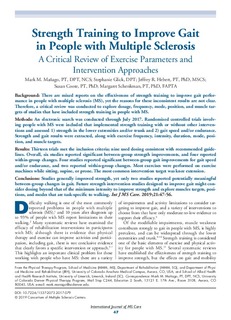| dc.identifier.citation | Mark M. Mañago, Stephanie Glick, Jeffrey R. Hebert, Susan Coote, and Margaret Schenkman (2019) Strength Training to Improve Gait in People with Multiple Sclerosis. International Journal of MS Care: March/April 2019, Vol. 21, No. 2, pp. 47-56. | nb_NO |
| dc.description.abstract | Background: There are mixed reports on the effectiveness of strength training to improve gait performance in people with multiple sclerosis (MS), yet the reasons for these inconsistent results are not clear. Therefore, a critical review was conducted to explore dosage, frequency, mode, position, and muscle targets of studies that have included strength training in people with MS.
Methods: An electronic search was conducted through July 2017. Randomized controlled trials involving people with MS were included that implemented strength training with or without other interventions and assessed 1) strength in the lower extremities and/or trunk and 2) gait speed and/or endurance. Strength and gait results were extracted, along with exercise frequency, intensity, duration, mode, position, and muscle targets.
Results: Thirteen trials met the inclusion criteria; nine used dosing consistent with recommended guidelines. Overall, six studies reported significant between-group strength improvements, and four reported within-group changes. Four studies reported significant between-group gait improvements for gait speed and/or endurance, and two reported within-group changes. Most exercises were performed on exercise machines while sitting, supine, or prone. The most common intervention target was knee extension.
Conclusions: Studies generally improved strength, yet only two studies reported potentially meaningful between-group changes in gait. Future strength intervention studies designed to improve gait might consider dosing beyond that of the minimum intensity to improve strength and explore muscles targets, positions, and modes that are task-specific to walking. | nb_NO |
